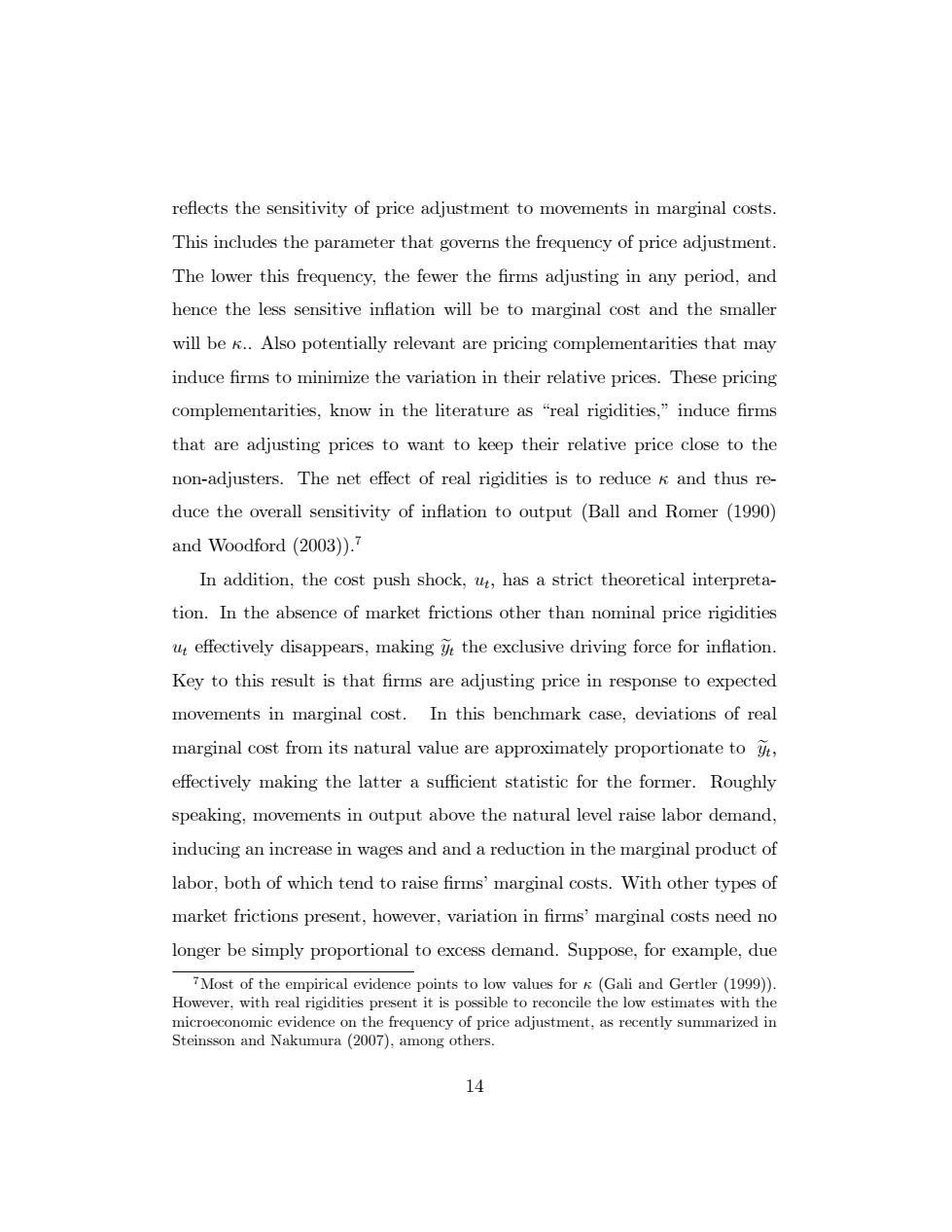正在加载图片...

reflects the sensitivity of price adjustment to movements in marginal costs. This includes the parameter that governs the frequency of price adjustment. The lower this frequency,the fewer the firms adjusting in any period,and hence the less sensitive inflation will be to marginal cost and the smaller will be K..Also potentially relevant are pricing complementarities that may induce firms to minimize the variation in their relative prices.These pricing complementarities,know in the literature as "real rigidities,"induce firms that are adjusting prices to want to keep their relative price close to the non-adjusters.The net effect of real rigidities is to reduce k and thus re- duce the overall sensitivity of inflation to output (Ball and Romer (1990) and Woodford(2003)).7 In addition,the cost push shock,ut,has a strict theoretical interpreta- tion.In the absence of market frictions other than nominal price rigidities ut effectively disappears,making yt the exclusive driving force for inflation. Key to this result is that firms are adjusting price in response to expected movements in marginal cost.In this benchmark case,deviations of real marginal cost from its natural value are approximately proportionate to yt, effectively making the latter a sufficient statistic for the former.Roughly speaking,movements in output above the natural level raise labor demand, inducing an increase in wages and and a reduction in the marginal product of labor,both of which tend to raise firms'marginal costs.With other types of market frictions present,however,variation in firms'marginal costs need no longer be simply proportional to excess demand.Suppose,for example,due 7Most of the empirical evidence points to low values for K(Gali and Gertler (1999)). However,with real rigidities present it is possible to reconcile the low estimates with the microeconomic evidence on the frequency of price adjustment,as recently summarized in Steinsson and Nakumura(2007),among others. 14reáects the sensitivity of price adjustment to movements in marginal costs. This includes the parameter that governs the frequency of price adjustment. The lower this frequency, the fewer the Örms adjusting in any period, and hence the less sensitive ináation will be to marginal cost and the smaller will be .. Also potentially relevant are pricing complementarities that may induce Örms to minimize the variation in their relative prices. These pricing complementarities, know in the literature as ìreal rigidities,î induce Örms that are adjusting prices to want to keep their relative price close to the non-adjusters. The net e§ect of real rigidities is to reduce and thus reduce the overall sensitivity of ináation to output (Ball and Romer (1990) and Woodford (2003)).7 In addition, the cost push shock, ut ; has a strict theoretical interpretation. In the absence of market frictions other than nominal price rigidities ut e§ectively disappears, making yet the exclusive driving force for ináation. Key to this result is that Örms are adjusting price in response to expected movements in marginal cost. In this benchmark case, deviations of real marginal cost from its natural value are approximately proportionate to yet ; e§ectively making the latter a su¢ cient statistic for the former. Roughly speaking, movements in output above the natural level raise labor demand, inducing an increase in wages and and a reduction in the marginal product of labor, both of which tend to raise Örmsímarginal costs. With other types of market frictions present, however, variation in Örmsímarginal costs need no longer be simply proportional to excess demand. Suppose, for example, due 7Most of the empirical evidence points to low values for (Gali and Gertler (1999)). However, with real rigidities present it is possible to reconcile the low estimates with the microeconomic evidence on the frequency of price adjustment, as recently summarized in Steinsson and Nakumura (2007), among others. 14